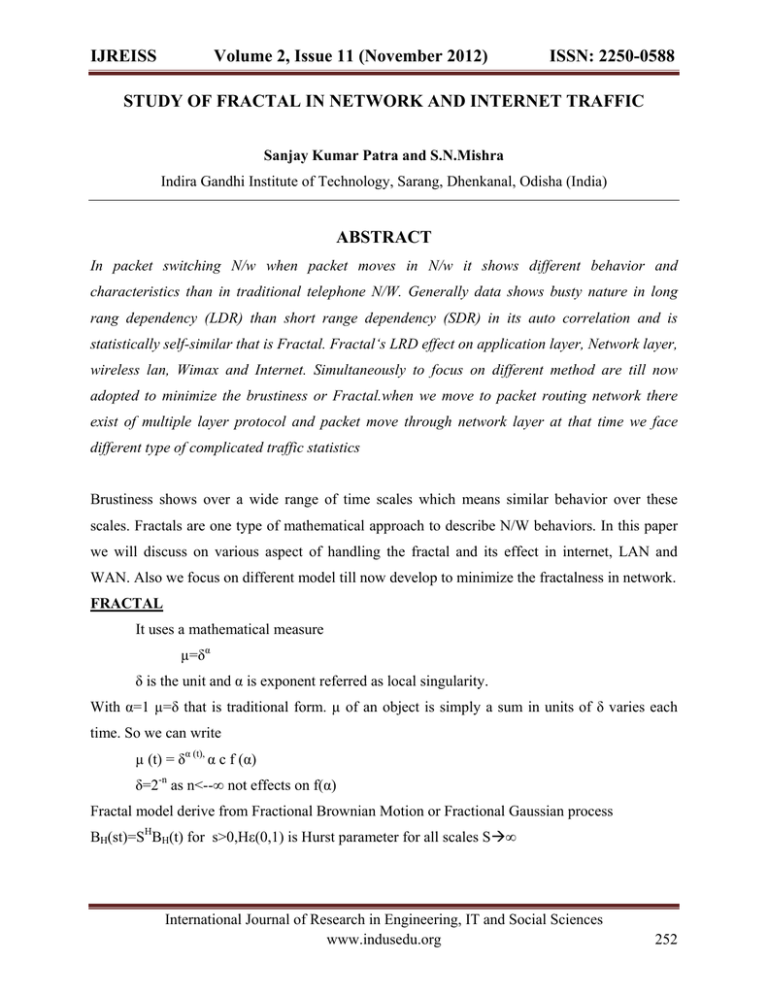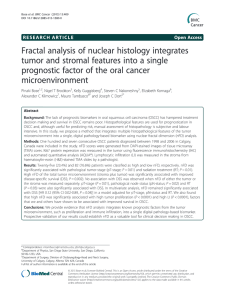
IJREISS
Volume 2, Issue 11 (November 2012)
ISSN: 2250-0588
STUDY OF FRACTAL IN NETWORK AND INTERNET TRAFFIC
Sanjay Kumar Patra and S.N.Mishra
Indira Gandhi Institute of Technology, Sarang, Dhenkanal, Odisha (India)
ABSTRACT
In packet switching N/w when packet moves in N/w it shows different behavior and
characteristics than in traditional telephone N/W. Generally data shows busty nature in long
rang dependency (LDR) than short range dependency (SDR) in its auto correlation and is
statistically self-similar that is Fractal. Fractal‘s LRD effect on application layer, Network layer,
wireless lan, Wimax and Internet. Simultaneously to focus on different method are till now
adopted to minimize the brustiness or Fractal.when we move to packet routing network there
exist of multiple layer protocol and packet move through network layer at that time we face
different type of complicated traffic statistics
Brustiness shows over a wide range of time scales which means similar behavior over these
scales. Fractals are one type of mathematical approach to describe N/W behaviors. In this paper
we will discuss on various aspect of handling the fractal and its effect in internet, LAN and
WAN. Also we focus on different model till now develop to minimize the fractalness in network.
FRACTAL
It uses a mathematical measure
µ=δα
δ is the unit and α is exponent referred as local singularity.
With α=1 µ=δ that is traditional form. µ of an object is simply a sum in units of δ varies each
time. So we can write
µ (t) = δα (t), α c f (α)
δ=2-n as n<--∞ not effects on f(α)
Fractal model derive from Fractional Brownian Motion or Fractional Gaussian process
BH(st)=SHBH(t) for s>0,Hε(0,1) is Hurst parameter for all scales S∞
International Journal of Research in Engineering, IT and Social Sciences
www.indusedu.org
252
IJREISS
Volume 2, Issue 11 (November 2012)
ISSN: 2250-0588
Figure 1: Synthesized traffic from a Poisson model vs. Internet traffic to which its mean
and variance were fitted, viewed over three orders of magnitude.
It is observed from the above figure
that the burstiness of the original
trace and the synthetic trace vary the
time scale of observation. The top
row shows a randomly selected subset
of each trace on a time scale of 100
msec; that is, each point in the plots
reflects
the
number
of
packets
observed during a 100 msec interval,
for a total of 6 sec. The second row
shows a time scale a factor of ten
larger: now, each point reflects the
number of packets per 1 sec, spanning
60 sec total. The black regions
illustrate from where the plots in the
row above were made. A key point is
that we not only have increased the
scale of the X-axis by a factor of 10,
but we have done the same to the Y-axis. With the third row we have again increased the scale in
both X and Y by a factor of ten and in the final row by another factor of six, such that here the
plots span the entire hour of the traces. [8,9]
PROBLEM IN PACKET N/W (INTERNET ) DESIGN
1. Brustiness to multiple time scales (Fractal)
2. Statical Properties not stationary.
3. Usage can change over short time scale.
4. Built upon diversity.
5. Size means rare event occur routinely.
6. Success Disasters (i.e. WWW)
International Journal of Research in Engineering, IT and Social Sciences
www.indusedu.org
253
IJREISS
Volume 2, Issue 11 (November 2012)
ISSN: 2250-0588
7. Unprecedented growth and scaling.
8. Topology constantly changing.
If we use internet packet data in telephone line then we may face following problem.
1. If data use over voice in telephone line such for fax or dial up internet then performance
degraded such that call blocking can be possible.
2. Design technique may not satisfactory if use for voice transfer because of use of digital
subscriber loop.
Self-similarity is mainly based on Heavy tailed file size it means The probability of given file
long the occurring falls off very slowly with increasing file length unlike ordinary distributions
where the rate of fall-off is much faster.[10]
MODELS APPROCHES TO RECTIFY FRACTAL(SELF-SIMILARITY OR LRD)
1. Poisson distribution
2. Gaussian fractional noise principle
3. Queuing theory (M/G/∞)
4. LRD (Fourier transformation for auto correlation)
5. Pareto distribution (Heavy tail)
6. Hrust parameter
7. Markovian models
8. Wavelet theory.
9.fractional ARIMA(FARIMA)
COMPLEXITY REQUIRE BY DIFFERENT ALGORITHM FOR SELF-SIMILARITY
FBNDP O(n),M/G/∞ O(n),fGn O(n),f-ARIMA O(n2), FFT O(n log n),wavelet fGn O(n)[7]
POISSON DISTRIBUTION
As per Poisson’s rule “call arrivals are mutually independent and call inter arrivals times
are all exponentially distributed with one and the same parameter λ .If X=(Xk :k>=1) denotes the
number of call arrivals in successive non overlapping time interval length ∆t >0, then x is the
increment process of Poisson process with parameter λ.
Then P [Xk=n)=e -λ∆t (λ∆t)n /n!, n>=0
International Journal of Research in Engineering, IT and Social Sciences
www.indusedu.org
254
IJREISS
Volume 2, Issue 11 (November 2012)
ISSN: 2250-0588
This rule can be described with 1 or just a few parameters are termed parsimonious.
Which is highly describing property?Telephonic property depend upon the rate λ of Poisson
process in dynamic call arrivals if λ=100/sec then time scale burtiness is around 10msec which is
greater than avg. activity and time scale vanishing rapidly.[9]For this reason we move for
Fractional Gaussian noise which strictly fractal in a sense.
GAUSSIAN FRACTIONAL NOISE
Instead of Possion based model we use very simple mathematical model called fractional
gaussion noise it is strictly fractional in a sense.
A covariance stationary Gaussian process X=(Xk :k>=1) is called fractional Gaussian
noise
HEAVY TAILED DISTRIBUTION
The probability of a given file length occurring falls off very slowly with increasing file length
unlike ordinary distributions where the rate of fall off is much faster.
1-F(x) =k1 x-β k1>0 and β ε [0, 2]
This is called heavy tail because it falls off very slowly with increasing values of x.In
heavy tailed distribution we may discuss about Pareto distribution. It is one type of probability
distribution whose tails are not exponentially bounded. They have heavier tails than the
exponential distribution.[10]
The distribution of random variance X with distribution function F is heavy right tail.
Lim
e λxPr[X>x]=∞ for all λ >0
x->∞
in distributed function
~f(x) =Pr[X.x}
As Lim
e λx~F(x)=∞ for all λ >0
x->∞
Pr[X.x] ~ x-α as x->∞ 0<α<2
LRD (LONG RANGE DEPENDENCY)
International Journal of Research in Engineering, IT and Social Sciences
www.indusedu.org
255
IJREISS
Volume 2, Issue 11 (November 2012)
ISSN: 2250-0588
The existence of substantial between the volume of traffic generated in widely separated time
interval. The self –similar or fractal behavior of traffic in WAN N/W pointing out the failure of
Poisson model to represent the strong correlations that exists at different temporal scales. Traffic
due to WWW is provided due to interconnection pattern in browser. Here we may consider
Fourier transformation for auto correlation and self-similar behavior we can go through Hurst’s
parameter. For traffic self-similarity is divided into two time scale that is SRD and LRD. It
shows that N/w transmission delay (RTT) separate these two.
In general bandwidth, TCPS window size and packet size have impacts on SRD but
statistical heavy tails affect the structures of LRD.
It is observe in multi fractal analysis that [1,2,3]
1. Increase bandwidth does not improve throughput that is N/W performance. Two factor
effecting traffic throughput that is Network delay and TCP window size.
2. At small time scale traffic brustiness varies so to improve performance and efficiency we
need to control bandwidth TCP window size and N/W delay to reduce brustiness.
FACTOR DEPENDING TO INFLUENCE SRD & LRD
1. Bandwidth
2. Delay
3. Number of connections
4. Packet size
5. TCP window sizes
6. Pareto shape factor of connection size(Heavy tail)
Among a number of fractal model FARIMA (Fractional Auto Regressive Integrated Moving
Avg.) and M/G/∞ is two famous example.FARIMA capture both SRD and LRD and success in
VBR (Variable Bit Rate) video modeling but it lacks connections with the N/W mechanisms e.g.
TCP and HTTP.M/G/∞ based on the aggregation of general ON/OFF process. Directly related to
heavy –tail properly of traffic e.g. connection and file size are heavy tailed.[6,7,8]
TWO BASIC CHARACTERISTICS WHICH DISTINGUISH SELF SIMILAR PROCESS
FROM CONVENTIONAL STOCHASTIC PROCESS
1.Increase of time scale 2 or more times in poisson model we obtain white noise.
International Journal of Research in Engineering, IT and Social Sciences
www.indusedu.org
256
IJREISS
Volume 2, Issue 11 (November 2012)
ISSN: 2250-0588
2.It require minimum number of parameter self similarity can be capture.
Traffic in network depend on application protocol like TELNET,FTP,SMTP,NNTP.in different
time scale they shows different behavior.TELNET,FTP and SMTP can be model for poisson for
one hour or 10 minute interval but NNTP and WWW cannot clearly represent through poisson
model even over a 10 minute time interval .[1,8]
CONCLUSION
When we discuss about fractal several question comes to our mind such as how to optimize the
self-similarity process? Which protocol layer we must focus to minimize delays in session in
transport layer ,minimize average packet delay in data link layer, minimize packet loss and again
transmit in network layer ,minimize delay in processing in new application in application layer.
For this now we can do by increasing the bandwidth or modifying TCP but that is not the
solution. The total work what we focus here are theoretically we may restrict the fractal process
but practical implementation is much require which is a further task. Internet traffic shows
brustiness at different time scale but still now we are using poisson principle in LAN and WAN
to abstain from fractal we have to create a model which is also a future task .[6,9,10]
REFERENCES
[1] Discussion of the Analysis of Self-similar Tele traffic with Long-range Dependence (LRD) at
the
Network
Layer Level G. Millán, H. Kaschel, G. Lefranc, Int. J. of Computers,
Communications & Control, ISSN 1841-9836, E-ISSN 1841-9844 Vol. V (2010), No. 5, pp.
799-812.
[2] W. Stallings, Redes e Internet de Alta Velocidad. Rendimiento y Calidad de Servicio, 2nd
ed., Madrid, Pearson - Prentice Hall, 2004, pp. 224-237.
[3]
Kleinrock, Information Flow in Large Communication Nets, Ph.D. Thesis, Research
Laboratory
of Electronics, Massachusetts Institute of Technology, Cambridge, MA, 1961.
[4]
L. Kleinrock, Communication Nets: Stochastic Message Flow and Delay, New York,
McGrawHill, 1964.
[5] W.E. Leland, M.S. Taqqu, W. Willinger, and D.V. Wilson, On the Self-Similar Nature of
International Journal of Research in Engineering, IT and Social Sciences
www.indusedu.org
257
IJREISS
Volume 2, Issue 11 (November 2012)
ISSN: 2250-0588
Ethernet Traffic, in Proc. ACM SIGCOMM ?93, San Francisco, CA, pp. 183-193.
[6]
Computers and Mathematics with Applications 54 (2007) 107–116,Fractal nature of
highway traffic data Pengjian Shang,Meng Wan, Santi Kama
[7] Mathematics and Computers in Simulation 80 (2010) 2040–2061,Fast simulation of selfsimilar and correlated processes_M.E. Sousa-Vieira , A. Suárez-González, C. López-García,
M. Fernández-Veiga, J.C. López-Ardao, R.F. Rodríguez-Rubio.
[8] From Poisson Processes to Self-Similarity: a Survey of Network Traffic Models ,Michela
Becchi, http://www.cse.wustl.edu/~jain/cse567-06/ftp/traffic_models1/index.html.
[9] Where Mathematics Meets the Internet;Walter Willinger and Vern Paxson;notices of the
AMS;Lawrence Berkeley nationallab., university of California, Berkeley, CA.
[10]A short tutorial on fractals and internet Traffic,Dr Thomas B Fowler,The telecommunication
review,1999.
International Journal of Research in Engineering, IT and Social Sciences
www.indusedu.org
258




